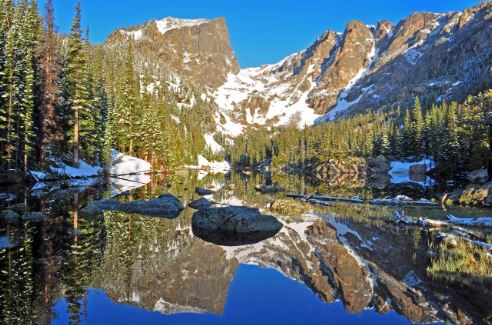7 Common Causes of Roof Damage in Colorado
Colorado might be one of the most scenic states in the country, but its weather doesn’t do your roof any favors. Between the snow, the sun, and those infamous summer hailstorms, even a brand-new roof can take a beating within a few short years. That’s one reason roofing companies in Denver stay busy all year long.
But not all damage is caused by obvious storms or dramatic events. Sometimes, it’s the slow and silent wear that causes the most expensive problems.
Here are seven common causes of roof damage Colorado homeowners should be aware of.
1. Hailstorms
Colorado consistently ranks among the top states for hail-related insurance claims. The Insurance Information Institute reports that hail causes billions in property damage every year in the U.S., and Colorado is usually in the top five states affected by frequency and cost. Hail can break shingles, dent flashing, and wear down protective granules, even if the stones aren’t that large.
If the hail comes in sideways with wind, it may loosen parts of the roof edge or flashing. You might not notice the impact right away, but moisture can seep in and cause slow-developing damage under the surface.
Hail damage isn’t just cosmetic. Over time, bruised shingles lose their ability to repel water. This allows moisture to infiltrate the underlayment and eventually the wood decking. When that happens, repairs become more expensive because the structure underneath is compromised. Metal roofs aren’t immune either. While they hold up better, denting can still lead to issues with seams and fasteners. Homeowners should know that hail damage might still be covered by insurance even if it’s not immediately visible. That’s why documenting storms and having a roofer inspect your property afterward is a smart habit.
2. Snow Accumulation and Ice Dams
Snow itself isn’t always a problem. But when it builds up and then melts unevenly, you get ice dams. These dams form when heat from inside the house causes snow to melt on the upper part of the roof, and the water then refreezes at the colder roof edge.
This traps water on your roof, and shingles aren’t made to handle standing water. Eventually, it seeps under the roofing material and leads to wood rot, mold, or water-damaged insulation. It’s even worse on homes with poor attic ventilation or uneven rooflines.
3. High Winds
Gusty winds are frequent across the Front Range and mountain areas. They can lift shingles, curl their edges, or remove them entirely. Once a shingle goes missing, that area becomes vulnerable to water and UV exposure, which spreads the damage.
In neighborhoods with older roofs or inadequate sealing, strong windstorms can cause rapid deterioration. You may not see the full damage until months later when a leak appears during a rainstorm.
4. UV Exposure
Colorado gets more than 300 days of sunshine a year, and all that sun can dry out your roof materials. At higher elevations, the sun’s ultraviolet rays are even stronger, accelerating the aging process for asphalt shingles and roofing membranes.
The result? Shingles become brittle, start to crack, and lose their protective surface. On flat or low-slope roofs, UV rays can break down adhesives and cause seams to separate, letting in moisture over time.
UV damage can also affect materials like rubber and PVC used in flat roofs. These surfaces can develop cracks and blisters from heat stress. Over time, seams in roofing membranes may peel or shrink, creating entry points for water. Proper roof coatings or reflective materials can help slow the damage, but they need to be reapplied on schedule. Homeowners at higher elevations, like in Boulder or Colorado Springs, should be particularly vigilant, since UV intensity rises significantly with altitude.
5. Poor Installation
Even the best roofing materials won’t help much if they’re installed incorrectly. Misaligned shingles, improperly sealed flashing, and poor underlayment coverage can all cause issues, sometimes within the first few seasons.
Unfortunately, some roofers cut corners to save time or reduce costs. It’s one of the leading causes of premature roof failure. Always verify that a contractor is licensed, insured, and has good reviews from local customers before you sign anything.
6. Clogged Gutters
It might not sound like a big deal, but clogged gutters can be a slow killer for your roof. When gutters are full of leaves, pine needles, or debris, rainwater has nowhere to go. It backs up under the shingles along the edge of the roof and can damage the fascia and roof decking.
In Colorado’s fall and spring seasons, gutters can fill quickly, especially in areas with lots of cottonwood trees or pine. Regular cleanings twice a year can help prevent this silent source of damage.
7. Tree Limbs and Falling Debris
Trees provide great shade and curb appeal, but they can become a hazard in high winds or heavy snow. Overhanging branches scrape against shingles, loosen granules, or snap off during storms. In winter, the extra weight of snow or ice can bring limbs crashing down, sometimes penetrating right through the roof.
Even small debris can shorten your roof’s life over time, especially if it traps moisture or allows pests to find entry points. Trimming back limbs and clearing debris after storms helps keep your roof in better shape for longer.
Roof damage doesn’t always show up right away. Sometimes it’s the result of a dozen tiny problems that add up over the years. Staying on top of inspections and preventative maintenance goes a long way. And if you’re unsure whether your roof has hidden damage, it’s worth consulting a professional.
While it’s tempting to wait for visible signs of damage, roofs often fail quietly. Water finds the smallest weakness and spreads fast. That’s why annual inspections are so important, especially in a place like Colorado where the climate throws just about everything at your roof. The cost of catching a problem early is usually a fraction of what it costs to repair the damage later on.
A healthy roof means fewer repairs, better energy efficiency, and less stress every time the weather turns. And in Colorado, that peace of mind is worth its weight in roofing nails.




